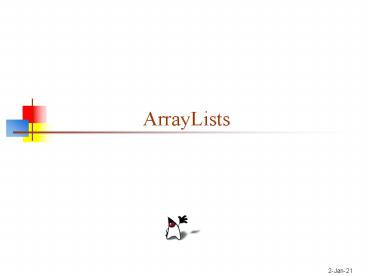ArrayLists - PowerPoint PPT Presentation
Title:
ArrayLists
Description:
The advantage of a ArrayList is that you don't need to know beforehand how big to make it ... an array that you hope is 'big enough' use a ArrayList instead ... – PowerPoint PPT presentation
Number of Views:88
Avg rating:3.0/5.0
Title: ArrayLists
1
ArrayLists
2
ArrayLists and arrays
- A ArrayList is like an array of Objects
- Differences between arrays and ArrayLists
- Arrays have special convenience syntax
ArrayLists dont - An array is a fixed size, but a ArrayList expands
as you add things to it - This means you dont need to know the size
beforehand - Arrays can hold primitives or objects, but
ArrayLists can only hold objects - However, autoboxing can make it appear that an
ArrayList can hold primitives - We will discuss autoboxing in some other lecture
3
Creating a ArrayList
- Specify, in angle brackets after the name, the
type of object that the class will hold - Examples
- ArrayListltStringgt vec1 new ArrayListltStringgt()
- ArrayListltStringgt vec2 new ArrayListltStringgt(10)
- (10 is the initial size you want)
- This is sort of like an array, where you would
say String ary new String10instead
of ArrayListltStringgt ary new
ArrayListltStringgt(10)
4
Adding elements to a ArrayList
- boolean add(Type obj)
- Appends the object obj to the end of this
ArrayList - The obj must be of the correct type, or you get a
compile-time (syntax) error - Always returns true
- This is for consistency with other, similar
classes - void add(int index, Type element)
- Inserts the element at position index in this
ArrayList - The index must be greater than or equal to zero
and less than or equal to the number of elements
in the ArrayList - The obj must be of the correct type, or you get a
compile-time (syntax) error
5
Removing elements
- boolean remove(Object obj)
- Removes the first occurrence of obj from this
ArrayList - Returns true if an element was removed
- Uses equals to test if it has found the correct
element - void remove(int index)
- Removes the element at position index from this
ArrayList - void clear()
- Removes all elements
6
Getting values out
- Type get(int index)
- Returns the component at position index
- Using get
- ArrayListltStringgt myList new ArrayListltStringgt()
myList.add("Some string")String s
myList.get(0)
7
Searching a ArrayList
- boolean contains(Object element)
- Tests if element is a component of this ArrayList
- Uses equals to test if it has found the correct
element - int indexOf(Object element)
- Returns the index of the first occurrence of
element in this ArrayList - Uses equals to test if it has found the correct
element - Returns -1 if element was not found in this
ArrayList - int lastIndexOf(Object element)
- Returns the index of the last occurrence of
element in this ArrayList - Uses equals to test if it has found the correct
element - Returns -1 if element was not found in this
ArrayList
8
Getting information
- boolean isEmpty()
- Returns true if this ArrayList has no elements
- int size()
- Returns the number of elements currently in this
ArrayList - Type toArray(Type )
- Returns an array containing all the elements of
this ArrayList in the correct order - The parameter is usually a zero-length array of
the correct type - Example String names nameList.toArray(new
String0)
9
More about equals
- There are many different notions of equality
- Example two sets are equal if they contain the
same elements order of elements is irrelevant - Java defines public boolean equals(Object) in the
Object class, but - equals is defined to be the same as
- Its often a good idea to override equals for
your own objects - If you do this, note that the argument should be
a general Object - The String class (and some others) override
equals
10
Conclusion
- A ArrayList is like an array of Objects
- The advantage of a ArrayList is that you dont
need to know beforehand how big to make it - The disadvantage of a ArrayList is that you cant
use the special syntax for arrays - You should never use an array that you hope is
big enoughuse a ArrayList instead
11
The End
Where a calculator on the ENIAC is equipped with
18 000 vacuum tubes and weighs 30 tons, computers
of the future may have only 1 000 vacuum tubes
and perhaps weigh 1½ tons.
--Popular Mechanics, March 1949































